Erosion Control Toolbox: Compost
Introduction

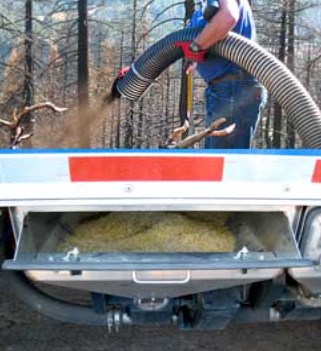
The compost bid item refers to two distinctly different types of work. Compost may be applied as a mulch-like blanket onto disturbed soil areas, or it may be applied to a slope and mixed together with other materials (such as bark, straw or topsoil) when used with Incorporate Materials. A compost blanket provides several benefits, including protecting bare soil surfaces from wind and water erosion, water conservation, weed control, and providing nutrients required for long term, sustainable vegetation. Compost used with Incorporate Materials provides a source of nutrients required for establishment of vegetation.
When to Use These Treatments
- Use compost where disturbed site soils are sterile, compacted, and/or low in nutrients
- Compost blankets are typically applied to slopes 1.5:1 (H:V) and flatter. The following application rates are suggested:
- Slopes 1.5:1 (H:V) - 1" maximum thickness
- Slopes 2:1 (H:V) - 2" maximum thickness
- Slopes 3:1 (H:V) - 3" maximum thickness
- Slopes 4:1 (H:V) - 4" maximum thickness
Benefits of Compost Blankets
- Improved protection from raindrop splash erosion
- Reduced competition from weed species
- Reduced stormwater runoff volume and velocity
- Improved infiltration rate
- Conserves soil moisture
- Improved soil biology - activity by bacteria, mycorrhizal fungi, nematodes, protozoa, microarthropod and earthworms
- Improved soil nutrient levels and nutrient cycling
- Improved potential for vigorous long term sustainable vegetation
Compost Blanket Limitations
- Compost may blow away in high wind areas - consider tacking in place with Hydromulch, or covering with RECP Netting (Type A)
- Temporary storage within the project limits may be required to stockpile the compost
- Compost may require additional erosion control treatment in areas with significant rain events
Design Considerations for Compost Blankets
- Verify compost availability - check producers list at: US Composting Council (USCC) Seal of Testing Assurance (STA) Program Participants
- Determine if new slopes will require incorporation of organics to support sustainable vegetation
- Specify "Medium" or "Coarse" compost materials for compost blanket work to minimize loss due to wind
The photos below highlight common erosion control combinations, together with their strengths and weaknesses.
Compost Blanket
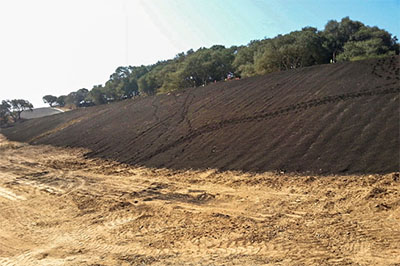
This photo shows a compost blanket applied to a slope with no additional treatments layered on top. If compost is applied with a pneumatic blower truck, seed can be placed in a side bin in the truck and applied with the compost in a single step. For this method, all slope areas must be within 300 feet from the blower truck as the blower truck hose is just 300 feet long.
Compost Blanket, Straw, Incorporated (Or Crimped)
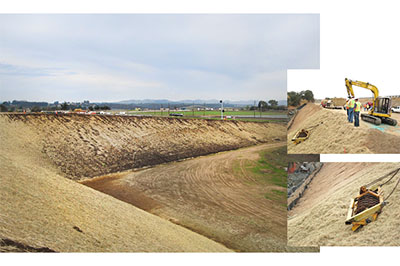
This photo shows a 2” Compost Blanket, topped with blown Straw, then incorporated in place with a crimper. The crimp adds an additional step that requires an additional piece of equipment which can be costly. A more cost effective approach to hold compost in place is shown directly below.
Compost Blanket, Straw, Tacked With Hydromulch
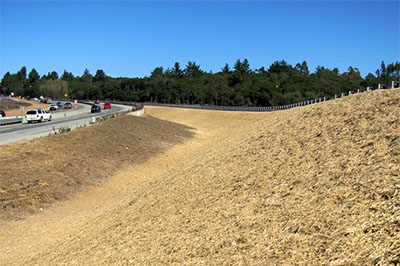
This photo shows a 2” Compost Blanket, topped with blown Straw and held in place by applying a layer of Hydromulch (a combination of tackifier and fiber). This combination of "S" treatments is cost effective and reliable for 2:1 (H:V) slopes up to 30 ft in length. Straw is excellent at protecting soil and compost from raindrop erosion while providing a mulch for effective seed germination.
Compost Blanket, Rolled Erosion Control Product (RECP)(Netting)(Type A)

This photo shows a 2” compost blanket covered by RECP(Netting)(Type A). This is a costly and effective method of preventing erosion and retaining compost and seed in areas subject to high winds and/or highly erosive rain events. In the photo above, compost berms are used instead of fiber rolls. Applying the RECP(Netting)(Type A) on top of both the compost blanket and berms is recommended. This method is more cost effective than placing the compost berms on top of netting and reduces the likelihood that the compost berm will biodegrade the netting.
Coarse Compost And Trash Content
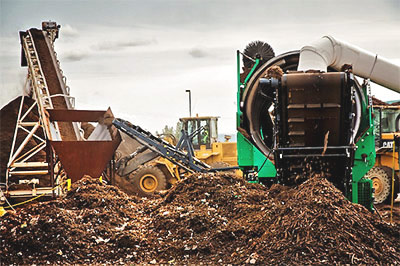
It is possible to purchase medium or coarse compost with low trash content, but coarser compost materials often have a higher level of trash (plastic) than fine compost products. Compost producers can remove trash (plastic) during the production process, but this increases cost. If you cannot obtain medium or coarse compost free of plastic, specify fine (3/8" minus) compost materials covered with bark mulch, and use Incorporate Materials to combine them in place. This method provides the benefits of a coarser compost product with less trash.
Common Compost Application Rates
| Compost Depth | Cubic Yards/Acre | Pounds/Acre | Tons/Acre |
|---|---|---|---|
| 1/2" | 68.5 | 54,800 | 27 |
| 1" | 135 | 108,000 | 54 |
| 2" | 270 | 216,000 | 108 |
| 3" | 405 | 324,000 | 162 |
Average Compost Weight = 800 lbs/cubic yard (1050 lbs/cubic meter)
Compost Application Methods
Large quantities of compost required for compost blanket can be applied to a flat project site using a dump truck and a bulldozer. For sites with steep slopes or areas inaccessible by vehicles, a pneumatic blower truck may be used to rapidly apply compost. A 40 cubic yard blower truck holds roughly 35 cubic yards of compost, and applies material at a rate of about 35 cubic yards/hour. A single truck should be able to apply a 1" thick compost blanket over a 2-acre site (280 CY total) in a single working day. The truck hose can reach 300 feet, which is the maximum distance that can be reached from the roadway. A rough estimate of cost for labor and materials for this work would run from $5,000 - $8,000 per acre.
Application Rate Guidance for Compost
Several methods can be used to determine the compost application rate to provide the total nitrogen/acre necessary for sustainable vegetative establishment.
1. SOILS TEST
Perform a soil test to determine the best application rate for compost. If testing the soil is not feasible, use the methods below to estimate the ideal compost application rate.
2. ECOSYSTEM BASED SOIL NITROGEN/ACRE REQUIREMENT
An estimate for the proper amount of compost to add to the soil can be based upon typical total soil nitrogen levels found in each ecoregion. The table below identifies the amount of total nitrogen required for sustainable plant growth in various ecoregions. Use the Average Total Nitrogen LBS/Acre values found in the table to identify the compost application rate for the ecosystems identified.
| Ecoregion Description | Average Total Nitrogen LBS/AC |
| Minimum total N required to support vegetation (Bradshaw and others 1982) |
625 |
| Drastically Disturbed Sites | 700 |
| Desert Grassland | 800 |
| Minimum total N required to support vegetation in decomposed granite soils (Vic Claassen) | 1,100 |
| Shrub -Steppe Prairies | 4,500 |
| Deep Forest Soils | 20,000 |
3. MINIMUM SOIL ORGANIC MATERIAL (SOM) REQUIREMENT
The ideal compost application rate may also be determined by correlating it with typical minimum soil organic material (SOM) required to sustain healthy vegetation. Ideal SOM content varies based upon specific ecoregion vegetation and soil type. Research indicates that a sound SOM range is between 8-13%, which typically equates to 30% compost by volume in the soil. During the first growing season, seeded disturbed soil areas typically exhibit sparse vegetative cover, thus requiring available nitrogen levels as low as 50 pounds/acre. Applied nitrogen that exceeds plant requirements will not be utilized for plant growth and may leach to lower soil horizons. Recommended application rates below are based upon a target SOM rate of 8-13%, a Total Nitrogen/Acre range of 1,000 - 3,000 lbs/acre, and an available nitrogen amount of 100-300 lbs/acre. Lower application rates are recommended in arid regions or areas that typically receive less than 10 inches of precipitation per year. Higher application rates are recommended in decomposed granite soils or in ecoregions that support dense vegetation such as coastal forests. Specific site conditions will modify these general recommendations.
| Treatment | Total N / AC | Avail. N /AC First Year | Compost Rate CY / AC | Compost Rate Tons / AC | Soil Organic Matter % | Max. Recommended Slope (H:V) |
| 2" Compost incorporated in top 6" of soil | 2,160 Lbs | 216 Lbs | 270 | 96 | 8-13% | 3:1 |
| 3" Compost incorporated in top 9" of soil | 3,240 Lbs | 324 Lbs | 405 | 162 | 8-13% | 4:1 |
| 4" Compost incorporated in top 12" of soil | 4,320 Lbs | 432 Lbs | 540 | 216 | 8-13% | 4:1 |
Consider Using With
To hold compost in place on steep slopes or to protect from wind erosion, consider combining compost with:
To effectively treat sites with compacted, sterile or poorly draining soils, consider combining compost with:
Plans and Details
Estimate Information
- Use Bid Item Code 210610 Compost
References
- Thomas D. Glanville, Tom L. Richard, Russell A. Persyn, Impacts Of Compost Blankets On Erosion Control, Revegetation and Water Quality at Highway Construction Sites in Iowa. (PDF) April 2003.
- US EPA. 2000. Infiltration Through Disturbed Urban Soils and Compost-Amended Soil Effects on Runoff Quality and Quantity, 2000. (PDF)
- Washington State DOT Compost Amended Vegetated Filter Strips (PDF) Results from a study on vegetated roadside compost strips and water quality.
- David Steinfield, Scott Riley, Kim Wilkinson, Thomas D. Landis, Lee Riley, et al. 2017. "Roadside Revegetation, An Integrated Approach to Establishing Native Plants and Pollinator Habitat."
- US Composting Council Seal of Testing Assurance, Compost Producer Participants
- Model Guided Specification for Using Compost to Promote Establishment of Vegetation and Stormwater Quality Improvements, 2010 (PDF)
- U.S. E.P.A. Stormwater BMP - Compost Blankets, March 2012 (PDF)
This study establishes parameters for compost use based on performance criteria such as soil type, climate, slope length and steepness, aspect and location. It addresses how compost affects water quality and erosion, and how it improves establishment of sustainable vegetation.
-
Regeneration of Nitrogen Fertility in Disturbed Soils Using Compost (PDF)
Graphs nitrogen release from various composts and compares compost release rates with two native topsoils.
- Annual Sediment, Nitrogen and Phosphorus Losses From Bare And Compost Amended Fill Slopes (PDF)
Updated: November 8, 2019

